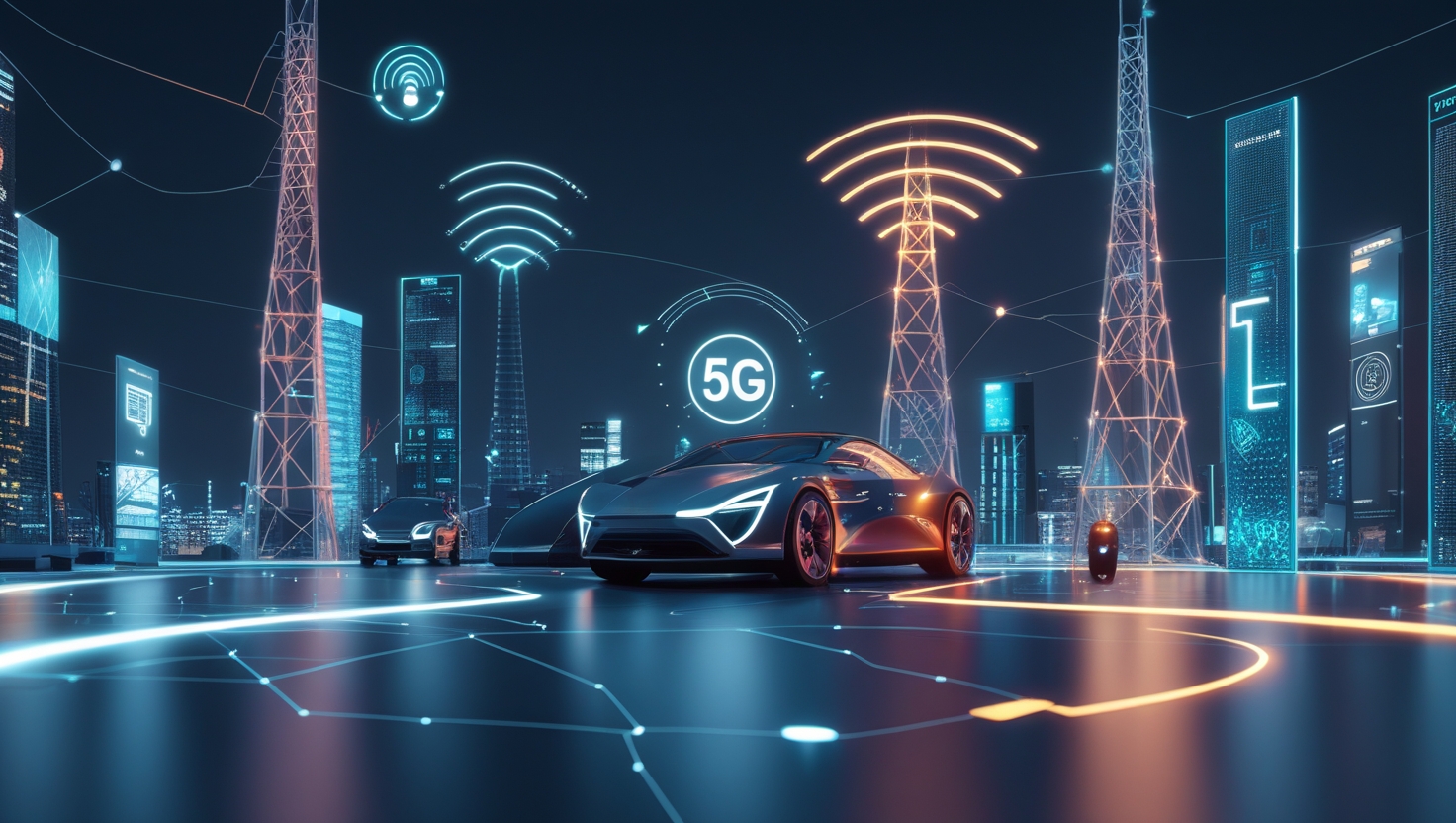5G generation represents a superb bounce within the evolution of verbal exchange networks, building upon the standards laid via its predecessors—2G, 3G, and 4G. As the fifth era of mobile networks, 5G is designed to decorate connectivity and remodel how we interact with generations. Its creation is pivotal in the digital panorama, promising quicker speeds, decreased latency, and extra exquisite device capability. This transformation will revolutionize diverse sectors, which include amusement, healthcare, and vibrant metropolis infrastructure.
- What is 5G?
- Differences Between Generations
- Blazing-Fast Speeds: The Impact of 5G on Internet Connectivity
- Reduced Latency: Real-Time Communication and Immediate Responses
- Enhanced Connectivity: The Role of 5G in the Internet of Things (IoT)
- Revolutionizing Remote Work and Collaboration
- The Future of Mobile Gaming: 5G and the Next-Gen Gaming Experience
- Smart Cities and the 5G Revolution
- Healthcare and 5G: A Game-Changer in Telemedicine
- Challenges and Limitations of 5G
- The Global Impact: 5G in Emerging Markets
- Conclusion
What is 5G?

5G, or fifth-generation wi-fi generation, is a modern advancement in mobile conversation that offers several key features:
- Faster Speeds: 5G networks can supply download hastens to a hundred times faster than 4G, with top speeds conducting up to 10 gigabits in step according to 2d (Gbps) in gold popular situations 3 4.
- Lower Latency: Latency refers to the time records travel from one point to another. 5G reduces this latency to as little as 1 millisecond, allowing near-instant communication to 8.
- Greater Network Capacity: 5G can simultaneously support hundreds of thousands of linked devices, making it ideal for Internet of Things (IoT) packages and smart towns 1 2.
Differences Between Generations
The evolution from 2G to 4G has visible significant improvements in velocity and functionality:
- 2G: Introduced in the early Nineteen Nineties, it centred on voice communication and essential statistics services like SMS.
- 3G: Launched in the early 2000s, cell internet gets admitted to speeds Brom masses of kilobits consistent with 2D to a few megabits in keeping with 2D.
- 4G: Introduced in the early 2000s, it provided speeds between five Mbps and 1 Gbps, allowing high-definition video streaming and improved mobile internet reports.
- 5G: represents a paradigm shift, with speeds from 1 Gbps to over 20 Gbps, ultra-low latency for actual-time applications, and considerable connectivity abilities 5 6.
Blazing-Fast Speeds: The Impact of 5G on Internet Connectivity
The incredible speed of 5G networks—as much as one hundred times faster than 4G—has profound implications for customers:
- Consumer Benefits: Users can experience quicker downloads, seamless streaming of excessive-definition content fabric, and ultra-responsive internet browsing. This velocity enhances normal activities like video conferencing and online gaming 3 7.
- Industry Transformation: Industries like entertainment and gaming will benefit considerably from the upgrades. For instance, cloud gaming will become possible, as players can play remarkable video games without lag. Remote work will also see upgrades, with quicker uploads and downloads for video calls 4 7.
Reduced Latency: Real-Time Communication and Immediate Responses
Latency is essential in figuring out how rapid information is transmitted between gadgets:
- The Importance of Low Latency: With latency reduced to milliseconds, applications requiring real-time interplay—including videoconferencing, telemedicine, and online gaming—will be extra effective 3 8.
- Autonomous Vehicles: 5 G’s low latency allows real-time statistics trade among automobiles and infrastructure, enhancing safety and performance in self-sufficient systems 8.
Enhanced Connectivity: The Role of 5G in the Internet of Things (IoT)
5G’s functionality to attach hundreds of thousands of devices concurrently is transformative:
- Smart Homes and Cities: The strong connectivity provided through Five G may additionally guide the rise of clever homes geared up with IoT devices. These include everything from clever thermostats to safety systems speaking seamlessly 1 6.
- Industrial Applications: Enhanced connectivity in industries like production and healthcare will allow for advanced automation and monitoring systems. With real-time data processing abilities, smart factories can perform more successfully 1 2.
Revolutionizing Remote Work and Collaboration
The shift to remote paintings has multiplied due to present-day worldwide sports:
- Improved Remote Work Experience: With quicker upload/download speeds and reduced latency, far-off personnel can experience seamless video calls and efficient collaboration through cloud computing tools 3 7.
- Impact on VR/AR: five G’s competencies can also help integrate virtual truth (VR) and augmented reality (AR) generation into places of work. These technologies can create immersive education environments or decorate a ways-flung collaboration studies 4 7.
The Future of Mobile Gaming: 5G and the Next-Gen Gaming Experience
Mobile gaming stands at the edge of a revolution thanks to the 5G technology:
- Cloud Gaming Potential: With immoderate-velocity connections permitting clean streaming of games at once from the cloud, gamers can experience console-exquisite studies on their cellular devices without the need for powerful hardware 3 4.
- Real-Time Multiplayer Gaming: Minimal lag will facilitate competitive multiplayer and responsive, appealing gaming reviews. This will allow for brand-spanking-new sports designs that rely upon real-time participant interactions 3 7.
Smart Cities and the 5G Revolution
The concept of smart towns is based closely on superior connectivity:
- Connected Infrastructure: 5G permits clever tourist manipulation systems that optimize drift based on real-time facts. Superior communique networks that permit faster emergency responses can also benefit public protection measures 1 2.
- Sustainability Initiatives: By enhancing strength distribution and waste management via related structures, towns can become extra sustainable whilst improving citizens’ exceptional lives 1 2.
Healthcare and 5G: A Game-Changer in Telemedicine
Telemedicine is ready to undergo desirable-sized improvements because of 5G:
- Enhanced Telehealth Services: Faster diagnostics through real-time records transmission will allow more powerful virtual consultations. Remote monitoring systems will offer nonstop health updates immediately 2 6.
- Robotic Surgeries: The precision required for robot surgical tactics may be finished through low-latency connections that allow surgeons to function remotely with minimum threat 2 8.
Challenges and Limitations of 5G
Despite its capability, several annoying situations remain:
- Infrastructure Requirements: Building a substantial network requires considerable infrastructure investment, including small mobile towers that beautify coverage, but they arrive for 7 8.
- Coverage Issues: Rural regions may also face demanding situations regarding access to reliable 5G offerings because reduced population density affects carrier profitability 6 7.
- Security Concerns: Increased connectivity raises concerns about record safety as more devices become interconnected. Sturdy protection protocols can be important 7 8 as reliance on those networks grows.
The Global Impact: 5G in Emerging Markets
The advantages of 5G increase past developed global locations:
- Bridging the Digital Divide: Developing international locations stand to advantage notably from stepped-forward connectivity through 5G networks. This technology can benefit the right of entry to education, healthcare offerings, and financial possibilities 6 7.
- Economic Development Potential: By facilitating new commercial agency fashions and enhancing infrastructure competencies, rising markets can harness the energy of digital transformation driven by using the 5G era 6 7.
In conclusion, the 5G generation is poised to revolutionize conversation and connectivity throughout multiple sectors. Its impact might be felt now in client reviews and how industries function—from healthcare innovations to brighter urban environments. As we look toward the future, the long-term potential of 5G remains massive, promising a further connected global wherein technology enhances our daily lives in high-quality ways.
Conclusion
The creation of the 5G era is set to revolutionize communication and connectivity across numerous sectors, changing how we engage with each technology and every unique one. With its promise of faster speeds, decreased latency, and excellent capability, 5G will enhance personal reviews in ordinary sports activities, streaming, gaming, and far-off paintings. Industries like healthcare, leisure, and transportation will benefit from real-time information exchange and superior operational efficiencies, paving the way for telemedicine and innovative metropolis infrastructure improvements.
As we include this new connectivity technology, we must deal with its stressful conditions, infrastructure funding, insurance disparities, and safety worries. However, five G’s ability benefits—particularly in bridging the digital divide in rising markets—are significant. By improving access to training, healthcare, and economic possibilities, 5G can substantially contribute to global improvement.
In precis, the 5G era is not an improvement; it’s a transformative pressure that guarantees to create an additional-associated international wherein era complements our everyday lives in super strategies. As we flow into this new landscape, the long-term implications of 5G will shape the destiny of communique and connectivity for generations to return.
FAQs
What are the advantages of 5G technology?
5G provides significant advantages: download speeds up to 100 times those of 4G; reduced latency — as low as 1 millisecond; and connections of millions of devices. These advancements improve user experiences in streaming, gaming, telecommuting, and real-time applications like telehealth.
What makes 5G different from previous generations, like 4G?
Whereas 4G improved upon 3G in speed and its usefulness from 5 Mbps to 1 Gbps, the scenario flips with a significant shift in the paradigm where 5G networks will serve from 1 Gbps to over 20 Gbps. 5G also supports ultra-low latency for real-time applications and massive connectivity for IoT devices.
How will 5G impact industries?
However, 5G is set to impact almost any industry by creating innovative technologies like cloud gaming, telemedicine, smart factories, and autonomous vehicles. For example, real-time data transmissions can help healthcare providers conduct better virtual medical consultations, while manufacturers can use them to enhance automation and monitoring systems.
What challenges come with 5G implementation?
Yes, there are hurdles to overcome in deploying 5G networks. These can be extensive infrastructure investments (including small cell towers), the possibility of rural areas having gaps in coverage due to less population density, making service providers unwilling to invest, or concerns about security risks from being more connected.
What impact will 5G have on emerging markets?
Emerging markets will greatly benefit from better connectivity with expanding 5G networks. Access to these services can be improved through technology, creating new economies in the process. By enabling digital transformation up to 10, 5G can bridge the digital divide of developed and developing regions.
What part will security have in the future of 5G?
Strong security protocols will be critical with 5G networks interconnecting even more devices. These benefits, however, come with the increased connectivity, causing concerns related to data security and privacy; thus, service providers need to focus on cybersecurity measures that can protect users and their information.
When will be the widespread adoption of 5G?
While many urban areas worldwide are already seeing widespread adoption of 5G, full deployment may still take years as infrastructure continues to be rolled out. This timeline can vary by region depending on the level of investment, regulatory framework, and market demand.
How does hosting these wireless pros help everyday consumers tap into 5G?
For everyday consumers, this essentially means faster downloads for streaming content, smoother online gaming with lower latency, smoother video conferencing for work or social activity, and better use of the smart home — all thanks to 5G technology.


